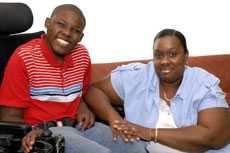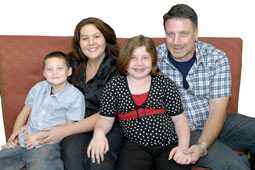Facts about Muscular Dystrophy

Muscular dystrophies are a group of diseases caused by defects in a person’s genes. Over time, this muscle weakness decreases mobility and makes the tasks of daily living difficult. There are many muscular dystrophies and the Centers for Disease Control and Prevention (CDC) studies the major types.
Different types of muscular dystrophy affect specific groups of muscles, have a specific age when signs and symptoms are first seen, vary in how severe they can be, and are caused by imperfections in different genes. Muscular dystrophy can run in the family, or a person might be the first one in their family to have the condition.
Muscular dystrophy is rare, and there is not a lot of data on how many people are affected by the condition. Much of the information comes from outside the United States. CDC scientists are working to estimate the number of people with each type of muscular dystrophy in the United States. The table below shows what is known about the major types of muscular dystrophy.
Types of Muscular Dystrophy
- Duchenne/Becker (DMD/BMD)
- Myotonic (MMD)
- Limb-Girdle (LGMD)
- Facioscapulohumeral (FSH)
- Congenital (CMD) and myopathies
- Distal (DD)
- Oculopharyngeal (OPMD)
- Emery-Dreifuss (EDMD)
How common is this type?
In 2007, 349 out of 2.37 million males aged 5-24 years were reported to have DMD or BMD in the United States.1 This means that about 15 out of every 100,000 males ages 5-24 years were affected that year.
In 2009, 233 out of 1.49 million males were reported to have DMD or BMD in Northern England.2 That is, about 16 out of every 100,000 males were affected that year.
Are males or females more likely to be affected?
Males
When does muscle weakness typically begin?
DMD: Before 5 years
BMD: Between 7-12 years
Which muscles usually show weakness first?
Upper arms, upper legs
What other parts of the body can be affected?
Brain, throat, heart, diaphragm/chest muscles, stomach, intestines, spine
References:
1. Emery AEH. The muscular dystrophies. The Lancet. 2002 Feb 23 2002;359(9307):687-695.
2. Bushby KM, Goodship JA, Nicholson LV, Johnson MA, Haggerty ID, Gardner-Medwin D. Variability in clinical, genetic and protein abnormalities in manifesting carriers of Duchenne and Becker muscular dystrophy. Neuromuscul. Disord. Jan 1993;3(1):57-64.
3. Bushby KM, Appleton R, Anderson LV, Welch JL, Kelly P, Gardner-Medwin D. Deletion status and intellectual impairment in Duchenne muscular dystrophy. Dev. Med. Child Neurol. Mar 1995;37(3):260-269.
4. Centers for Disease C, Prevention. Prevalence of Duchenne/Becker muscular dystrophy among males aged 5-24 years – four states, 2007. MMWR Morb. Mortal. Wkly. Rep. Oct 16 2009;58(40):1119-1122.
5. Norwood FL, Harling C, Chinnery PF, Eagle M, Bushby K, Straub V. Prevalence of genetic muscle disease in Northern England: in-depth analysis of a muscle clinic population. Brain. Nov 2009;132(Pt 11):3175-3186.
How common is this type?
In 2009, 316 out of 2.99 million individuals of all ages were reported to have MMD in Northern England.1 This means that about 11 out of every 100,000 people were affected that year.
Are males or females more likely to be affected?
Males and females equally
When does muscle weakness typically begin?
Between 10-30 years, but ranges from birth to 70 years
Which muscles usually show weakness first?
Face, neck, arms, hands, hips, lower legs
What other parts of the body can be affected?
Eyes, throat, heart, stomach, intestines, hormone-producing organs, nerves, skin
References:
1. Norwood FL, Harling C, Chinnery PF, Eagle M, Bushby K, Straub V. Prevalence of genetic muscle disease in Northern England: in-depth analysis of a muscle clinic population. Brain. Nov 2009;132(Pt 11):3175-3186.
2. Turner C, Hilton-Jones D. The myotonic dystrophies: diagnosis and management. J. Neurol. Neurosurg. Psychiatry. Apr 2010;81(4):358-367.
3. Gharehbaghi-Schnell EB, Finsterer J, Korschineck I, Mamoli B, Binder BR. Genotype-phenotype correlation in myotonic dystrophy. Clin. Genet. Jan 1998;53(1):20-26.
4. New nomenclature and DNA testing guidelines for myotonic dystrophy type 1 (DM1). The International Myotonic Dystrophy Consortium (IDMC). Neurology. Mar 28 2000;54(6):1218-1221.
5. Harper PS. Myotonic Dystrophy. Vol 37. 3 ed. London: W.B. Saunders; 2001.
6. Moxley RT, Pandya S, Ciafaloni E, Fox DJ, Campbell K. Change in Natural History of Duchenne Muscular Dystrophy With Long-term Corticosteroid Treatment: Implications for Management. J. Child Neurol. September 1, 2010 2010;25(9):1116-1129.
7. Moxley RT MG. The Myotonic Dystrophies. In: Rosenberg RN DS, Paulson HL, Ptacek L, Nestler EJ, ed. The Molecular and Genetic Basis of Neurologic and Psychiatric Disease. Philadelphia, PA: Wolters Kluwer; 2008:532-541.
How common is this type?
In 2009, 68 out of 2.99 million individuals of all ages were reported to have LGMD in Northern England.1 This means that about 2 out of every 100,000 people were affected that year.
Are males or females more likely to be affected?
Males and females equally
When does muscle weakness typically begin?
Ranges from early childhood to late adulthood
Which muscles usually show weakness first?
Shoulders, hips
What other parts of the body can be affected?
Heart, diaphragm/chest muscles, spine
References:
1. Norwood FL, Harling C, Chinnery PF, Eagle M, Bushby K, Straub V. Prevalence of genetic muscle disease in Northern England: in-depth analysis of a muscle clinic population. Brain. Nov 2009;132(Pt 11):3175-3186.
2. Emery AEH. The muscular dystrophies. The Lancet. 2002 Feb 23 2002;359(9307):687-695.
3. Guglieri M, Straub V, Bushby K, Lochmuller H. Limb-girdle muscular dystrophies. Curr. Opin. Neurol. Oct 2008;21(5):576-584.
4. Mathews KD, Moore SA. Limb-girdle muscular dystrophy. Curr. Neurol. Neurosci. Rep. Jan 2003;3(1):78-85.
How common is this type?
In 2009, 118 out of 2.99 million individuals of all ages were reported to have FSH in Northern England.5 This means that about 4 out of every 100,000 people were affected that year.
Are males or females more likely to be affected?
Males and females equally
When does muscle weakness typically begin?
By 20 years (average age in the teens)
Which muscles usually show weakness first?
Face, shoulders, upper arms, lower legs
What other parts of the body can be affected?
Eyes, ears, heart, trunk
References:
1. Norwood FL, Harling C, Chinnery PF, Eagle M, Bushby K, Straub V. Prevalence of genetic muscle disease in Northern England: in-depth analysis of a muscle clinic population. Brain. Nov 2009;132(Pt 11):3175-3186.
2. Emery AEH. The muscular dystrophies. The Lancet. 2002 Feb 23 2002;359(9307):687-695.
3. Awerbuch GI, Nigro MA, Wishnow R. Beevor’s sign and facioscapulohumeral dystrophy. Arch. Neurol. Nov 1990;47(11):1208-1209.
4. Tawil R, Van Der Maarel SM. Facioscapulohumeral muscular dystrophy. Muscle Nerve. Jul 2006;34(1):1-15.
How common is this type?
In 2009, 68 out of 2.99 million individuals of all ages were reported to have CMD in Northern England.1 This means that about 2 out of every 100,000 people were affected that year.
Are males or females more likely to be affected?
Males and females equally
When does muscle weakness typically begin?
At birth or in early infancy
Which muscles usually show weakness first?
Neck, arms, trunk, legs
What other parts of the body can be affected?
Brain, eyes, throat, heart, diaphragm/chest muscles, nerves, spine
References:
1. Norwood FL, Harling C, Chinnery PF, Eagle M, Bushby K, Straub V. Prevalence of genetic muscle disease in Northern England: in-depth analysis of a muscle clinic population. Brain. Nov 2009;132(Pt 11):3175-3186.
2. Reed UC. Congenital muscular dystrophy. Part I: a review of phenotypical and diagnostic aspects. Arq. Neuropsiquiatr. Mar 2009;67(1):144-168.
3. Wang CH, Dowling JJ, North K, et al. Consensus statement on standard of care for congenital myopathies. J. Child Neurol. Mar 2012;27(3):363-382.
4. Bertini E, D’Amico A, Gualandi F, Petrini S. Congenital muscular dystrophies: a brief review. Semin. Pediatr. Neurol. Dec 2011;18(4):277-288.
How common is this type?
In 2009, 10 out of 2.99 million individuals of all ages were reported to have DD in Northern England.1 This means less than 1 out of every 100,000 people were affected that year.
Are males or females more likely to be affected?
Males and females equally
When does muscle weakness typically begin?
Ranges from late teens to adulthood
Which muscles usually show weakness first?
Lower arms, hands, lower legs, feet
What other parts of the body can be affected?
Nerves, other muscles, depending on the type of DD
References:
1. Norwood FL, Harling C, Chinnery PF, Eagle M, Bushby K, Straub V. Prevalence of genetic muscle disease in Northern England: in-depth analysis of a muscle clinic population. Brain. Nov 2009;132(Pt 11):3175-3186.
2. Emery AEH. The muscular dystrophies. The Lancet. 2002 Feb 23 2002;359(9307):687-695.
3. Udd B. Distal muscular dystrophies. Handbook of clinical neurology. 2011;101:239-262.
4. Nonaka I. Distal myopathies. Curr. Opin. Neurol. Oct 1999;12(5):493-499.
How common is this type?
In 2009, 4 out of 2.99 million individuals of all ages were reported to have OPMD in Northern England.1 This means that less than 1 out of every 100,000 people were affected that year.
Are males or females more likely to be affected?
Males and females equally
When does muscle weakness typically begin?
After 40 years
Which muscles usually show weakness first?
Face (mostly around the eyes), neck, upper arms, upper legs
What other parts of the body can be affected?
Throat
References:
1. Emery AEH. The muscular dystrophies. The Lancet. 2002 Feb 23 2002;359(9307):687-695.
2. Norwood FL, Harling C, Chinnery PF, Eagle M, Bushby K, Straub V. Prevalence of genetic muscle disease in Northern England: in-depth analysis of a muscle clinic population. Brain. Nov 2009;132(Pt 11):3175-3186.
3. Ruegg S, Lehky Hagen M, Hohl U, et al. Oculopharyngeal muscular dystrophy – an under-diagnosed disorder? Swiss Med. Wkly. Oct 1 2005;135(39-40):574-586.
4. Bouchard JP, Brais B, Brunet D, Gould PV, Rouleau GA. Recent studies on oculopharyngeal muscular dystrophy in Quebec. Neuromuscul. Disord. Oct 1997;7 Suppl 1:S22-29
5. Brais B. Oculopharyngeal muscular dystrophy. Handbook of clinical neurology. 2011;101:181-192
How common is this type?
In 2009, 4 out of 2.99 million individuals of all ages were reported to have EDMD in Northern England.1 This means that less than 1 out of every 100,000 people were affected that year.
Are males or females more likely to be affected?
Males
When does muscle weakness typically begin?
Between 5-15 years
Which muscles usually show weakness first?
Upper arms, lower legs
What other parts of the body can be affected?
Heart, spine
References:
1. Norwood FL, Harling C, Chinnery PF, Eagle M, Bushby K, Straub V. Prevalence of genetic muscle disease in Northern England: in-depth analysis of a muscle clinic population. Brain. Nov 2009;132(Pt 11):3175-3186.
2. Emery AE. Emery-Dreifuss muscular dystrophy – a 40 year retrospective. Neuromuscul. Disord. Jun 2000;10(4-5):228-232.
3. Miller RG, Layzer RB, Mellenthin MA, Golabi M, Francoz RA, Mall JC. Emery-Dreifuss muscular dystrophy with autosomal dominant transmission. Neurology. Aug 1985;35(8):1230-1233.
Read about CDC’s Muscular Dystrophy Surveillance Tracking and Research Network, known as MD STARnet. Learn more about CDC’s other muscular dystrophy projects.
For more detailed information on each type of muscular dystrophy, see the summaries provided by Genetics Home Reference from the National Institutes of Health’s U.S. National Library of Medicine:
Duchenne/Becker Muscular Dystrophy
Facioscapulohumeral Muscular Dystrophy
Limb-Girdle Muscular Dystrophy
Congenital Muscular Dystrophy (Fukuyama type, Ullrich type, and others)
Distal Muscular Dystrophy (Laing, type 2, tibial type, and others)
Emery-Dreifuss Muscular Dystrophy
Oculopharyngeal Muscular Dystrophy
Early Intervention Services

Early intervention services help children learn important skills. These services can improve a child’s development. Even if the child has not been diagnosed with muscular dystrophy, he or she might be eligible for services. These services are provided through an early intervention system in each state. Through this system, you can ask for an evaluation. In addition, treatment such as physical therapy often does not need to wait for a formal diagnosis.
Learn more about early intervention »
Finding Support
Having support and community resources can help increase confidence in managing muscular dystrophy, enhance quality of life, and help meet the needs of all family members. It might be helpful for parents of children with muscular dystrophyto talk with one another. One parent might have learned how to address some of the same concerns another parent has. Often, parents of children with special needs can give advice about good resources for these children.
The choices of one family might not be best for another family, so it’s important that parents understand all options and discuss them with their child’s health care providers.
If you have a child with muscular dystrophy, you might:
- Connect with the Muscular Dystrophy Association to get information about clinics, support groups, and summer camps.
Find families and events in your area through the Parent Project Muscular Dystrophy, an organization whose work focuses on Duchenne muscular dystrophy.
- Page last reviewed: January 13, 2017
- Page last updated: April 7, 2016
- Content source:



 ShareCompartir
ShareCompartir